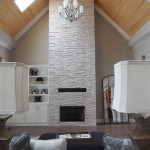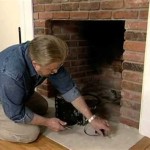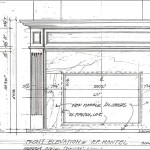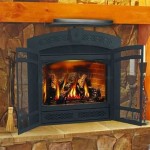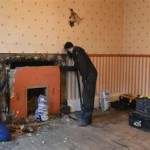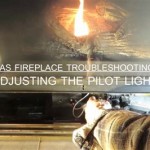Limestone Fireplace Surrounds For Wood Burners
Limestone fireplace surrounds offer a timeless aesthetic and practical functionality when paired with wood-burning stoves and fireplaces. The natural stone provides a durable, heat-resistant barrier while enhancing the visual appeal of the hearth. Selecting the appropriate limestone surround for a wood burner involves understanding the material properties, design considerations, installation requirements, and maintenance protocols.
Limestone, a sedimentary rock composed primarily of calcium carbonate, exhibits a range of colors, textures, and densities. Its inherent properties make it a suitable material for fireplace surrounds, particularly those intended for use with wood burners. The stone's ability to absorb and radiate heat contributes to energy efficiency, while its non-combustible nature ensures safety. The porous characteristics of limestone allow it to "breathe," reducing the risk of cracking or warping under high temperatures.
The diverse aesthetic options available with limestone allow homeowners to integrate the fireplace surround seamlessly into a variety of interior design styles. From rustic, textured finishes to sleek, modern designs, limestone can be customized to match individual preferences and architectural themes. The inherent variations in color and veining within limestone slabs contribute to the unique character of each surround, making it a focal point of the living space.
Benefits of Limestone Fireplace Surrounds
Limestone fireplace surrounds provide several distinct advantages over other materials, especially when used with wood-burning stoves. These benefits relate to heat resistance, aesthetics, and durability.
Heat Resistance and Safety: The primary advantage of a limestone fireplace surround is its exceptional heat resistance. Wood-burning stoves generate considerable heat, requiring a non-combustible barrier to protect surrounding walls and materials. Limestone, being a natural stone, provides an inherently fire-resistant shield. This thermal stability minimizes the risk of fire hazards and contributes to the overall safety of the home. The heat absorption and slow release properties of limestone also help to maintain a consistent temperature within the room.
Aesthetic Versatility: Limestone is available in a wide array of colors, textures, and finishes, making it highly adaptable to different design styles. From the warm, earthy tones of Tuscan limestone to the cool, contemporary shades of honed limestone, the options are virtually limitless. This versatility allows homeowners to create a fireplace surround that complements their existing décor or serves as a statement piece within the room. The natural veining and variations in color within limestone slabs add depth and character, ensuring that each surround is unique.
Durability and Longevity: Limestone is a remarkably durable material that can withstand the rigors of daily use and the constant exposure to heat from a wood-burning stove. Properly installed and maintained, a limestone fireplace surround can last for generations. Its resistance to scratching, chipping, and staining ensures that it retains its aesthetic appeal over time. The solid, robust nature of limestone makes it a worthwhile investment for homeowners seeking a long-lasting and visually appealing fireplace solution.
Design Considerations for Limestone Fireplace Surrounds
When selecting a limestone fireplace surround for a wood burner, several design considerations should be taken into account. These relate to the size and proportions of the surround, the style and finish of the stone, and the integration of the surround with the overall architectural design of the room.
Size and Proportions: The size of the fireplace surround should be proportionate to the size of the room and the firebox opening. A surround that is too large can overwhelm the space, while one that is too small may appear insignificant. Careful consideration should be given to the height, width, and depth of the surround to ensure a balanced and harmonious aesthetic. The firebox opening should also be accurately measured to ensure a proper fit and to maximize the efficiency of the wood-burning stove.
Style and Finish: Limestone is available in a variety of styles and finishes, each offering a unique aesthetic appeal. Honed limestone provides a smooth, matte finish that is ideal for contemporary designs, while tumbled limestone offers a rustic, textured look that is well-suited for traditional settings. The choice of finish will influence the overall character of the fireplace surround and its integration with the surrounding décor. The color of the limestone should also be carefully considered to complement the other elements within the room, such as the wall color, flooring, and furniture.
Architectural Integration: The fireplace surround should be designed to integrate seamlessly with the overall architectural design of the room. Whether the room is modern, traditional, or transitional, the surround should reflect the existing style and enhance the overall aesthetic. Consider the architectural details of the room, such as crown molding, baseboards, and window trim, when selecting a design for the fireplace surround. The surround should not only serve as a functional element but also as a decorative feature that enhances the visual appeal of the space.
Installation and Maintenance of Limestone Fireplace Surrounds
Proper installation and regular maintenance are essential to ensure the longevity and aesthetic appeal of a limestone fireplace surround. Adhering to manufacturer guidelines and employing professional installation techniques are crucial for safety and performance. Consistent cleaning and preventative measures will help to protect the stone from staining and damage.
Installation Procedures: The installation of a limestone fireplace surround is a complex process that requires specialized skills and knowledge. It is highly recommended to hire a qualified professional to ensure that the surround is installed correctly and safely. The installation process typically involves preparing the wall surface, applying a mortar or adhesive to the back of the limestone slabs, and carefully positioning the slabs to create a seamless finish. Proper leveling and alignment are essential to ensure that the surround is structurally sound and visually appealing. After the surround is installed, it should be sealed with a protective sealant to prevent staining and water damage.
Cleaning and Sealing: Regular cleaning is essential to maintain the aesthetic appeal of a limestone fireplace surround. Use a mild, pH-neutral cleaner and a soft cloth to wipe down the surface of the stone. Avoid using harsh chemicals or abrasive cleaners, as these can damage the finish and cause discoloration. Sealing the limestone is crucial to protect it from staining and water damage. A high-quality sealant should be applied every 1-2 years, or as recommended by the manufacturer. This will create a protective barrier that prevents liquids from penetrating the surface of the stone.
Preventative Measures: Taking preventative measures can help to extend the life of a limestone fireplace surround and minimize the need for repairs. Use a fireplace screen to protect the surround from sparks and embers. Avoid placing flammable materials near the fireplace. Regularly inspect the surround for cracks or damage, and address any issues promptly. By taking these simple precautions, you can ensure that your limestone fireplace surround remains a beautiful and functional feature of your home for many years to come.
In conclusion, limestone fireplace surrounds offer a blend of aesthetic appeal, durability, and heat resistance, making them a practical and attractive choice for wood-burning stoves. Understanding the various aspects of limestone, from its intrinsic properties to the nuances of design and installation, empowers homeowners to make informed decisions. With careful planning and consistent maintenance, a limestone fireplace surround can become a cherished focal point of the home, providing warmth and beauty for generations to come.

Gallery Pisa Portuguese Limestone Fireplace Flames Co

Abingdon Portuguese Limestone Fireplace Surround Bonfire

Limestone Fireplaces For Wood Burning Multi Fuel Stoves Coal Gas Fires

Provence Portuguese Limestone Fireplace Surround Bonfire

Delamere 54 Portuguese Limestone Suite Authorised

Limestone Fireplace Surrounds For Wood Burners Freestanding Surround

Axon Brompton Limestone Fireplace With Reeded Chamber From Direct Stoves

Yorkshire Limestone Tudor Arch Fireplace Stoves Fireplaces

Grisedale Wood Burning Stove Suite Brompton Limestone Mantel Cast Fireplaces

Axon Sworth Limestone Fireplace With Chamber From Direct Stoves
Related Posts

